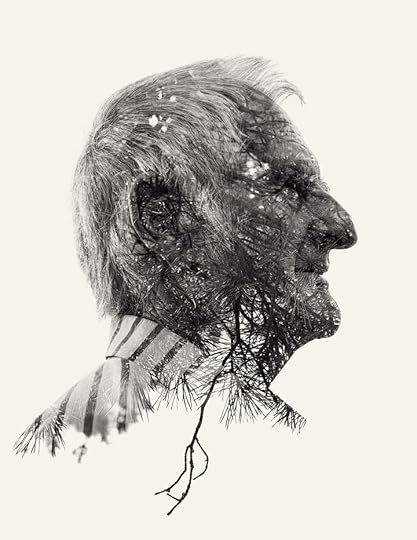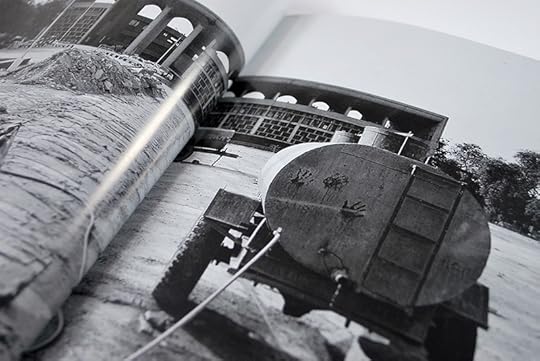Khoi Vinh's Blog, page 141
April 2, 2013
The Beauty of Letterpress Gallery
Just launched today, this gallery “…presents letterpress work from notable letterpress printers, designers, and artisans from around the country including Rohner Letterpress, Studio on Fire, Two Paperdolls, and Mama’s Sauce. The site features selections from a new curator each month. Letterpress history, context, educational information, community connections and a list of letterpress printers round out the site.”
In addition, the site aims to assist The Hamilton Wood Type & Printing Museum “in their efforts to relocate and effectively salvage a priceless piece of letterpress history.” The marquee video explains the daunting challenge that the museum faces, and the site urges fans of letterpress to donate to the cause.
Visit The Beauty of Letterpress.
To follow me on Twitter click here.

April 1, 2013
Catch of the Day
This is several years old but new to me: Surfrider Foundation teamed up with advertising agency Saatchi & Saatchi LA to produce this environmental awareness campaign. They collected real trash from local beaches, packaged them up and brought them to local farmers’ markets.
Read more in this old blog post at Shape+Color.
To follow me on Twitter click here.

March 29, 2013
Analyzing Tigger
Animator Michael Ruocco breaks down seven seconds of the 1977 Disney children’s classic “The Many Adventures of Winnie the Pooh,” in which animator Milt Kahl brings the character Tigger to exuberant life. This analysis is the very definition of a committed craftsperson: it is a nuanced, careful examination of every piece of the work at hand, filtered through a clear-eyed appreciation for the craftspeople who have come before. For designers, it’s just the umpteenth reminder that even very small details add up. Read the full blog post at Cartoon Brew.
To follow me on Twitter click here.

March 28, 2013
Double-exposure Photography
I’ve always had a soft spot for double-exposure photography, and how it crosses over from image capture into a form of graphic design. I’m most impressed when the exposures are all done in the camera (rather than in Photoshop), because to me it seems very close to laying out elements in the real world.
Here is some work from two photographers who have really mastered the form. They both work in very similar styles, and I have no idea if one can claim precedent over the other, so I’ll just list them alphabetically.
First off is Anette Ivanova.
And here’s work from Christoffer Relander.
I’ve put together this Bitly bundle which points to portfolios for each.
To follow me on Twitter click here.

March 27, 2013
Wufoo Feed Sponsorship

Wufoo? Who? It’s a web application that lets you build amazing online forms for your websites.
We host everything. We build the backend. You get an easy, fun and fast way to collect and analyze data, and it even integrates with many payment systems.
With Wufoo you get…
Over 200 pre-made templates & themes from our form gallery
Ability to customize branding with your own logo and themes to match
Integration with over 50 web apps including WordPress, MailChimp, Basecamp, Stripe, etc.
Support for beautiful typography with custom fonts and Typekit integration
Just because you’re working with forms and data doesn’t mean you have to do it without personality or style. Gathering information from your users is exciting, why shouldn’t your tools be exciting too?
Experience the difference. Sign up for Free and get started with Wufoo today.

Magic and Mobile Apps
Apple long ago abandoned its original “Magical and Revolutionary” tagline for the iPad, probably out of some embarrassment at how the word ‘magical’ made so many of us groan. But the more I use, build and learn about touch-based software, the more I think magic is really a key component of this stuff, even if it’s not exclusive to the iPad.
I thought about this recently when a co-worker introduced me to Moves, an iPhone app that tracks the number of steps you take, with the aim of getting you to be more physically active from day to day. Once downloaded, you use Moves by doing… well, almost nothing. The app does everything for you, recording and parsing out your steps by mapping where you’ve traveled over the course of the day, how far and how fast, all with no user intervention required. All you have to do is the walking part, and the app quite literally does the rest, generating a complete, metered itinerary for all the walking and (most of) the places you visited in a given day.
Less Typing Equals More Output
This automation is the headline feature of Moves, and with good reason. It’s no small thing to completely absolve the user of all data entry obligations, to passively collect what other apps would demand users actively enter (and to do so without draining battery life at inordinate levels). This feat directly addresses one of the central pain points of most mobile software: typing is a chore.
No one wants to type more on a multi-touch phone or tablet if they don’t have to, so when they see an app demonstrate that typing can be eliminated entirely, it’s an eye-opening moment, for sure. But is it magic? Almost. To simplify is huge, but what matters just as much is the end result, what the user gets out of the simplification. If the simplified process produces satisfactory results, great. But it’s magic when the software generates a disproportionately meaningful output from that minimized input.
Moves really couldn’t ask for a lower level of effort to use it. And yet the output is several orders of magnitude greater than that input: it’s automatic; it’s real time; it’s accurate; it’s recognizable; it’s useful; it’s beautifully presented and it just works. Even better, everyone I know can’t stop talking about how cool it is.
This inverse relationship between active user input and automated output is wonderfully consistent with how real people use mobile software. Unlike desktops, mobile devices are more often than not complements to other, real world activities, where ‘computing’ is not the main activity. Phones and tablets are used in situ, and so their software cannot afford to demand high levels of input effort. The trick here — the magic — is to ask for less from the user while at the same time raising, increasing, augmenting, or biggerizing the output so that it exceeds expectations, so that it᾿s out of scale to the reduced input.
Many of my favorite mobile apps do this: Instagram requires only that you press the shutter button in order to produce a beautiful photo; Shazam requires only that you hold up your phone in order to identify any song being played near you; Dark Sky requires only that you open it up to know all that you need to know about going outside in the next hour, etc. Magic is what Apple is going after with Siri (just tell your phone what you want) and what Google is going for with Google Now (do whatever you were going to do, and we’ll help you do what’s next). It’s even the same idea behind stalled innovations like NFC (just wave your phone to transact) and QR codes (just point your phone at a blotchy thing for more information). Magic is hard.
The Value of New
In fact, magic is not even as simple as I’ve described it here so far — the output needs to be amazing but it also needs to be original. The history of software is rife with examples of magic that later faded; for those accountants to whom Dan Bricklin and Bob Frankston first demonstrated VisiCalc in 1979, spreadsheets were magic because they reduced the input effort and scaled up the output disproportionately. Enter numbers in a few cells and perform any kind of arithmetic on them, instantly. That was pretty amazing then, but over the years it has become decidedly pedestrian.
My formula for magic comes with a corollary, then: it demands a certain amount of freshness. The software needs to produce a result that is both out of scale and of a type that is new, unexpected, or unfamiliar — the designer has to be the first (or among the first) to perform a given trick for the audience. And of course, the more often you see a trick, the less impressive it gets, to the point where pulling a rabbit out of a top hat becomes mundane.
Moves could have presented all of the data it collected in a humdrum table view, leaving you to make sense of it on your own. Instead it generates a novel visualization of your day’s walking, replete with dimensional graphics, drop shadows, incidental iconography and arguably superfluous gradients. It’s more than just your data, collected; it’s your day designed. There’s nothing quite like it out there that I’ve seen, but I’m sure that will change soon.
As much as I’ve tried to express this idea as a kind of formula, it goes without saying that conjuring up magic is rarely easy, and hardly predictable. Only a handful of apps out of the hundreds of thousands in the market have managed to capture this idea, at least for my money. But I think understanding this relationship between reduced user input and out-of-scale, novel outputs is a useful guide for the apps that are still to come. Grasping the concept makes the challenge easier, though only mildly so. By its very nature this will always remain a difficult thing to pull off. Magic is not a science, after all.
Thanks to Felix Salmon, Semil Shah and David Jacobs for reading early drafts of this post via the awesome new Editorially app.
To follow me on Twitter click here.

March 26, 2013
Brutalism in Print
Designer and critic Michael Abrahamson’s Fuck Yeah Brutalism tumblelog is a favorite. It provides a steady stream of historical photographs of the brutalist style, a postwar mode of architecture that favored the emphatic use of cast concrete and brick at huge and often inhumane scales. Looking back on what was built in this style, it strikes me that brutalism is the closest that architecture ever came to replicating the horrific beauty of a multi-car pileup.
Now Abrahamson is bringing brutalism to architecture magazine Clog as guest editor for the current issue. The folks at Clog were nice enough to send some sneak peek shots at the interior of the issue.
You can’t look away, but you can order your copy here.
To follow me on Twitter click here.

March 25, 2013
Disimages

The Disimages project aims to subvert the commercial stereotypes propagated by stock photography with decidedly weird alternatives.
To follow me on Twitter click here.

March 21, 2013
Swissted
New York designer Mike Joyce has been producing hypothetical gig posters for some of his favorite bands from the punk and post-punk era, designed in the style of Swiss Modernism. Each one is set in lowercase Berthold Akzidenz-Grotesk Medium. There are plenty more of them to see at Swissted.com, and Quirk Books has collected them into a book.
To follow me on Twitter click here.

March 20, 2013
The Race for Mobile News
Here is a quick list I made of some of the many mobile news apps that have entered the market over the past few years: Prismatic, Circa, Pulse, News 360, Summly, and Zite. These are all serious, well-funded and/or well-staffed entrepreneurial attempts at building the next great news brands. You can probably name at least a few others.
To some degree or another, they all propose to define a new kind of news reading experience that lies at the intersection of mobile access and customizable headlines. Some of them are pretty good at it, too. But none of them have truly come to own this category, and similarly none of them have become indispensable mobile brands the way that say Instagram has.
This situation puzzles me, because reading the news is one of the core use cases on a mobile phone — just about everyone does it. It surprises me that we’re almost six years into the iPhone-fueled smartphone era, and we don’t yet have a commonly agreed upon winner among news apps. Not just a clear leader in downloads, installs and active users, but an outright brand leader, an approximate equivalent to what CNN was in the first decades of cable news.
There is a distinction, of course, between producing original news, like CNN does, and aggregating or repackaging it, like almost all of these apps do. And maybe the fact that these brands have already come up against the limits of their popularity suggests that aggregation will always be inferior to original news.
I wouldn’t be surprised if in the long run that turns out to be the case; research suggests that legacy news brands enjoy an advantage in mobile (at least for now).
Still, I highly doubt that the combination of mobile access and customized headlines has already played itself out fully. While I take nothing away from what these apps have done so far, it strikes me that we are still just learning what mobile news consumption means, and how it’s very different from traditional or even desktop media models. As our understanding matures, new apps and brands will enter the market with radically different interaction models.
If you also have a little bit of faith that technology will continue its heretofore unceasing forward march, then it becomes quite reasonable to expect that we are due for huge innovations in relevance and automated customization sometime in the next decade, which will benefit this category of software immensely. That is, solutions to the challenge of creating a news experience tailored just for your interests (explicit and implicit) are bound to get more and more sophisticated — and accurate. The company that is the first to combine such technology with a truly advanced understanding of mobile news consumption will become the next great news brand.
To follow me on Twitter click here.

Khoi Vinh's Blog
- Khoi Vinh's profile
- 5 followers














